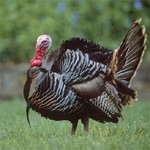By BOB HOOD
 Meleagris gallopavo – wild turkey
Meleagris gallopavo – wild turkey
Stationary turkey decoys are being displaced by more reliable string- or remote-control operated motion decoys.
What's the trick to turkey hunting?
Tricking the turkeys.
Until recent years, most turkey hunters relied on mouth-blown or hand-operated calls and a stationary decoy or two. The calls haven't changed much, but many manufacturers are putting new life in fake hens and gobblers.
Hunters no longer have to rely on stationary decoys, which don't always work. Just ask Robert Cantrell, owner of Texas Outdoors in Fort Worth and an officer in the Northeast Tarrant County Chapter of the National Wild Turkey Federation.
"I have seen times where a gobbler starts to approach a decoy and then suddenly stops and begins to shy away as if saying, 'I'm not so sure about this,'" Cantrell said. "He probably had been called to decoys before. Decoys often work great for tricking gobblers, but I think some gobblers that have been called up to a decoy become educated and become harder to call in on some occasions."
Adding motion could change that.
Hunters have a choice of spring-loaded decoy stakes that provide motion from the wind, pull strings that bring the decoys toward them and battery-powered motorized decoys that can be activated with remote controls.
A word of warning: When hunting on private property, other hunters should be informed about where the decoys are going to be used so that a hunter doesn't shoot at a decoy and put a nearby hunter at risk. Extreme caution with decoy setups should be exercised when hunting on public land.



